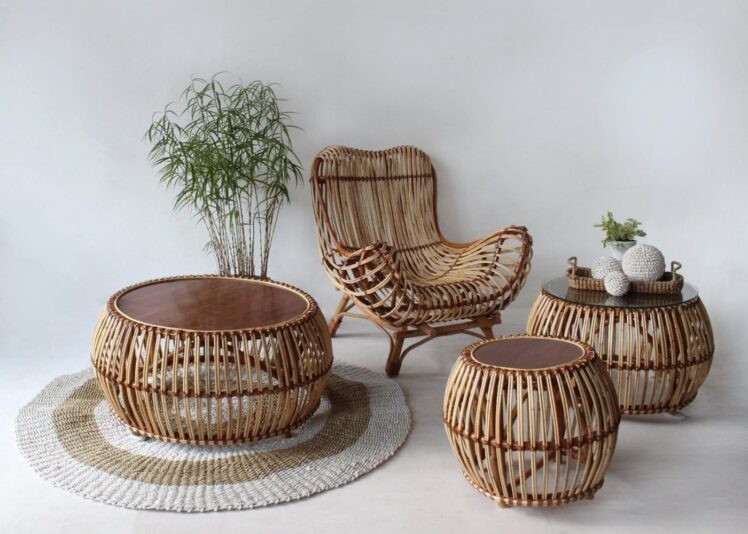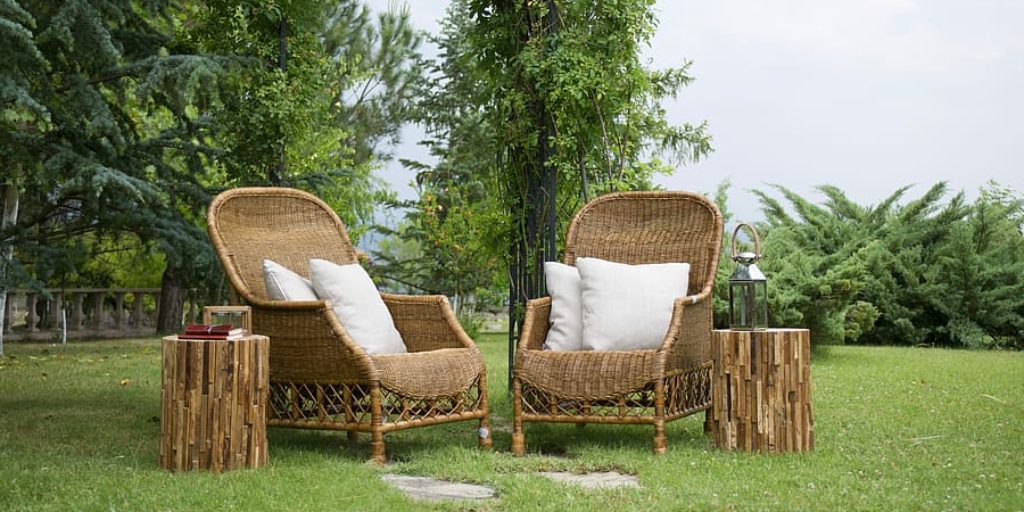
Bamboo is a proliferating sustainable material, often reaching maturity in just a few years. It’s also renewable and doesn’t require replanting after harvesting, as the root system remains intact. Bamboo furniture is known for its strength and durability. It can withstand heavy weights and daily use, making it suitable for chairs, tables, and beds.
Furniture from bamboo has gained popularity in recent years due to its eco-friendliness, durability, and unique aesthetic appeal. Despite its strength, bamboo is lightweight, making it easy to move furniture around and rearrange your space. Bamboo can be crafted into various furniture styles, from modern and sleek designs to more traditional or rustic looks. It can also be combined with other materials like glass, metal, or fabric to create unique pieces.
Bamboo’s natural grain and color variations give each piece of furniture a unique and organic look. It adds warmth and character to any space. Bamboo furniture is relatively low maintenance. Regular dusting and occasional cleaning with a damp cloth are usually sufficient to keep it looking great.
While some high-end bamboo furniture pieces can be pricey, many affordable options are available, making bamboo furniture accessible to a wide range of budgets. When purchasing bamboo furniture, it’s essential to ensure its sourced from responsibly managed bamboo forests to support sustainable practices and minimize environmental impact.
Vintage Bamboo Furniture

Vintage bamboo furniture, often associated with mid-century modern or tropical aesthetics, has a timeless charm and unique appeal. Here are some key characteristics and tips for incorporating vintage bamboo furniture into your home decor:
Vintage bamboo furniture is typically made from natural bamboo poles or rattan, which are lightweight yet sturdy. The natural variations in color and texture give each piece a unique and rustic look. Typical pieces include lounge chairs, dining sets, bar carts, shelving units, and accent tables, characterized by sleek lines, curved silhouettes, and woven rattan details.
It blends well with various interior styles, from bohemian and eclectic to coastal and tropical. Proper care and maintenance are essential to preserve the beauty and integrity of vintage bamboo furniture.
Whether you’re drawn to its retro allure or appreciate its sustainable and natural qualities, vintage bamboo furniture adds character, warmth, and a sense of history to any home environment. Embrace its timeless appeal and showcase its beauty in your living spaces for years.
Can Bamboo Furniture Be Outside?
Bamboo furniture can be used outdoors, but it requires proper care and maintenance to ensure durability and longevity in outdoor environments. Bamboo furniture can be used outside because of its weather resistance, material selection, protective coatings, proper placement, regular maintenance, storage during winter, inspection and repair.
Bamboo Outdoor Furniture
Bamboo outdoor furniture offers a stylish, eco-friendly option for furnishing outdoor spaces. Here’s why it’s a popular choice:
High-quality bamboo outdoor furniture is treated to withstand outdoor conditions such as rain, sunlight, and humidity. This treatment helps prevent warping, splitting, and mold growth, ensuring longevity even when exposed to the elements.
Bamboo is naturally strong and durable, making it suitable for outdoor furniture. When properly constructed and maintained, bamboo furniture can last for many years, providing excellent value for your investment.

As with indoor bamboo furniture, outdoor bamboo furniture is eco-friendly because bamboo is a renewable and sustainable resource. Choosing bamboo helps reduce the demand for traditional wood and contributes to environmental conservation efforts. Despite its strength, bamboo outdoor furniture is lightweight and easy to move around your outdoor space. This feature is convenient for rearranging furniture or storing it during inclement weather.
Bamboo’s natural texture and color lend a touch of organic beauty to outdoor settings, enhancing the overall ambiance of your patio, garden, or balcony. Outdoor bamboo furniture typically requires minimal maintenance. Regular cleaning with a mild detergent and water and occasional reapplication of protective coatings helps preserve its appearance and performance over time.
When selecting bamboo outdoor furniture, consider factors such as construction quality, weather resistance treatments, and design aesthetics to ensure you choose pieces that meet your needs and preferences while enhancing your outdoor living experience.
How to Restore Bamboo Furniture?
Restoring bamboo furniture can breathe new life into weathered or worn pieces, extending their longevity and preserving their natural beauty. Here’s a general guide on how to restore bamboo furniture:
Start by assessing the condition of the bamboo furniture. Look for any signs of damage, such as cracks, splits, loose joints, or mold/mildew growth. Note areas that need repair or restoration.
Thoroughly clean the furniture to remove dirt, dust, and grime. Use a soft brush or cloth to gently scrub the surface with a mild detergent or a mixture of water and vinegar. Avoid using harsh chemicals that could damage the bamboo.
Repair any cracks, splits, or loose joints in the bamboo. Apply wood glue to the affected areas, then carefully clamp the pieces until the glue dries. For larger repairs, you may need to reinforce the joints with screws or bamboo dowels.
If the bamboo surface is rough or uneven, lightly sand it with fine-grit sandpaper to smooth out imperfections and remove any old finish. Be gentle to avoid damaging the bamboo fibers.
Choose an appropriate finish for bamboo furniture, such as varnish, lacquer, or oil. Apply the finish evenly with a brush or cloth, following the manufacturer’s instructions. Allow the finish to dry completely between coats and apply multiple coats for protection.
Consider applying a protective coating to enhance the durability and weather resistance of the bamboo furniture. Polyurethane or marine-grade varnish are good options for outdoor furniture, while wax or polish may benefit indoor pieces.
Once the finish is dry, reassemble the furniture and ensure all joints are secure. Check for any remaining issues or touch-ups before placing the furniture back in its intended location.
Regular maintenance is essential to keep restored bamboo furniture in good condition. Clean the furniture regularly, avoid prolonged exposure to sunlight and moisture, and periodically reapply finish or protective coatings.
By following these steps and taking proper care of your bamboo furniture, you can restore its appearance and functionality, allowing you to enjoy it for years.
How to Clean Bamboo Furniture?
Cleaning bamboo furniture is relatively straightforward and requires only a few simple steps to maintain its natural beauty and longevity.
Dust removal is the first initiative in cleaning. Begin by removing dust and loose debris from the surface of the bamboo furniture using a soft brush, microfiber cloth, or vacuum cleaner with a brush attachment. Pay attention to corners, crevices, and joints where dust may accumulate.
:max_bytes(150000):strip_icc()/use-castile-soap-to-clean-house-1707114-09-828ceee7a01f4b97a037e375d23c6585.jpg)
Spot cleaning is the second step. For stubborn stains or spills, dampen a clean cloth with water, mild dish soap, or a gentle household cleaner. Dab the stained area, careful not to saturate the bamboo with excess moisture. Avoid using abrasive cleaners or harsh chemicals that could damage the bamboo fibers.
The third step is rinsing. After spot cleaning, rinse the area with a clean, damp cloth to remove any soap residue or remaining dirt. Ensure thorough rinsing to prevent soap buildup, which can attract more dust and dirt over time. After cleaning, dry the bamboo furniture thoroughly with a clean cloth to avoid water damage or warping. Allow the furniture to air dry completely before using it or applying any finishes or protective coatings.
If desired, you can polish bamboo furniture to restore its natural shine and enhance its appearance. Use a small amount of bamboo oil or furniture polish applied to a clean cloth, then gently rub it onto the surface of the bamboo in a circular motion. Buff the furniture with a dry cloth to remove any excess polish and achieve a smooth finish.
To maintain the cleanliness of your bamboo furniture, regularly dust it with a soft cloth or vacuum cleaner to remove surface debris. Avoid placing hot items directly on the bamboo surface, which can cause discoloration or damage. Use coasters or placemats to protect the furniture from spills, stains, and scratches.
If your bamboo furniture is used outdoors, consider applying a weather-resistant finish or protective coating to shield it from moisture, sunlight, and other outdoor elements. Follow the manufacturer’s instructions for proper application and reapplication of the protective layer as needed.
Following these cleaning tips and practicing regular maintenance, you can keep your bamboo furniture looking clean, vibrant, and well-maintained for years to come.
How to Refinish Bamboo Furniture?
Refinishing bamboo furniture can breathe new life into worn or outdated pieces, restoring their natural beauty and extending their lifespan.
Assessment is the first step in refinishing bamboo furniture. Begin by assessing the condition of the bamboo furniture. Note any scratches, dents, stains, or areas where the finish has worn off. Determine whether any repairs or structural adjustments are needed before refinishing.
Preparation is the second step. Prepare your workspace by covering the floor or work surface with a drop cloth or newspaper to protect it from drips and spills. If working indoors, ensure adequate ventilation to dissipate fumes from refinishing products.
Cleaning is the third step. Thoroughly clean the bamboo furniture to remove dirt, dust, and grime. Use a mild detergent or wood cleaner diluted in water and a soft cloth or sponge to scrub the surface gently. Rinse with clean water and allow the


